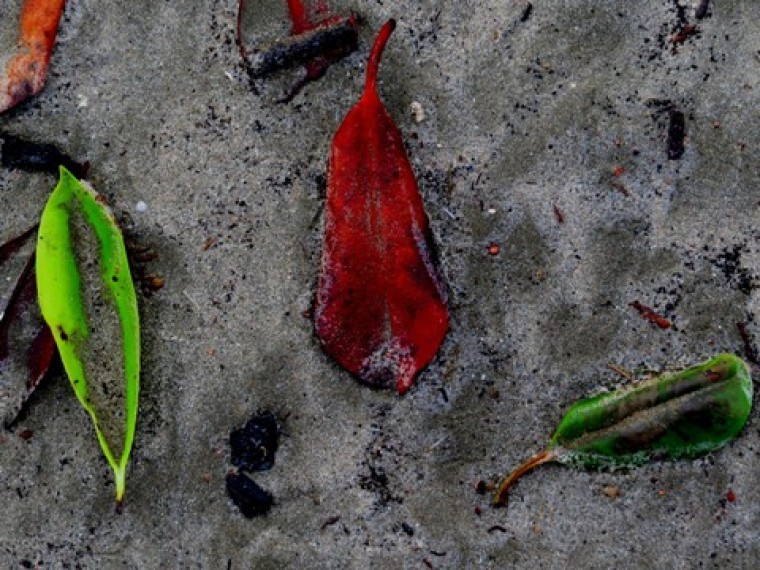
Many years ago at a my sister-in-law's workplace, she says they all had 'flu vaccinations by means of a little pressure-pump device that squirted the vaccine in through the skin on our arm. But this doesn't seem to have become a commonplace methodology.
However, there is hope for those who don't like injections, as there are a few techniques described below, that may put an end to the horror of "the needle".
A beautiful sea leaf is hope
Vaccinations have been a public health success during the last 100 years.
In a previous article, I have given the evidence (and supporting statistics) about the effectiveness of vaccines in preventing many diseases and deaths (particularly in children). This is emphasised by a recent post concerning the USA, but equally applicable to similar societies such as ours. (www.vaccines.gov)
We don't see some of these horrific or disabling diseases anymore because of public health measures where the majority of people are vaccinated. The viruses and bacteria causing them are still around, and when a certain proportion of people are not immunised, many kids and adults in the population can become seriously ill – or can pass on the disease to others. Sometimes, in developing nations when there is war, famine or social disruption and vaccination is not possible.
Then we see the reappearance of diseases such as polio and measles; and in some communities in our society where parents choose not to vaccinate for whatever reason, whooping cough is making a comeback with a vengeance (this is often passed onto little babies by adults who are not even aware they are ill).
If you are a parent considering vaccination, I would strongly recommend you read information on the "pros" as well as some of the other populist material you may find online. Make sure you get information from different sources, not just the same material re-posted over again – check your sources are from legitimate research or statistical analysis before following "something someone says". (Some useful references are in my previous article). (christiantoday.com.au)
A discussion of many areas of vaccination and disease control was aired on SBS TV on Sunday 13th July in a program entitled "Jabbed: Love, Fear and Vaccines" (www.sbs.com.au)
Proverbs 13:17 (NIV) advises us that: "A wicked messenger falls into trouble but a trustworthy envoy brings healing".
Safer 'flu vaccines for kids
The University of Sydney has reported that its ongoing survey of the safety of vaccines (AusVaxSafety surveillance) that the 2014 seasonal influenza vaccine is safe for children under five years of age. Of 735 children surveyed, only a small percentage had mild reactions and these were all resolved within 2 days with no adverse or "serious" reactions reported by parents or guardians. (theconversation.com)
Kids are fascinated by interesting items
"Patches" applied to the skin
But, effective as our vaccination programs now are, no-one likes having injections. After nine years of tests and trials, Professor Mark Kendall of Brisbane, with an international team of scientists, has developed a postage-sized "patch" to deliver vaccines directly to the skin. It is now ready for clinical trials.
''To the naked eye it looks like a patch,'' Professor Kendall said. ''But if we look under a microscope, we see thousands of projections that we dry-coat vaccine to ...Those little projections breach through the tough outer layer of the skin and deliver the vaccines, directly to thousands of immune cells.''
If successful in these trials, the patch will offer several advantages over an injection. The first, of course, is the elimination of pain. The second is that the vaccine is a dry powder and not a liquid solution, so it does not need refrigeration (and it is less bulky, meaning much cheaper and easier transportation). The third, and possibly most important, is that it will only cost about 50c for 3 doses rather than the current $50, so it will be very important in supplying vaccines to those in developing countries. In fact, if it is initially successful in the clinic in Brisbane, one of the first field trials is planned in Papua New Guinea in about 18 months' time. (www.smh.com.au)
Sniffing your medicine.
Another line of enquiry has led to the successful development of some vaccines as a nasal spray. These vaccines use nanotechnology: the engineering of a vaccine from parts of the virus or bacterium at the tiny, tiny level of individual molecules.
Not only will these nasal vaccines be cheaper and need no refrigeration, therefore (like the skin patches), will make vaccination campaigns easier in developing countries, but the components of the vaccine can be tailored more effectively to enhance people's immunity without them necessarily having the side-effects of a mild form of the disease (as often happens with conventional immunisation, because that is the way our current vaccines are designed to work).
This research was presented recently at a major meeting of the American Chemical Society. (www.sciencedaily.com)
In summary ...
… vaccination technology and efficacy has improved over the past 100 years, and public health has benefitted immensely from this (particularly the survival of babies and children under five). However, doctors and medical scientists are not sitting back on their laurels thinking they have finished the job, but are undertaking continual and ongoing research to make more effective and safer vaccines that are cheaper and easier to administer.
I, for one, will be happy to see the disappearance of "the needle"!
Here's one for hope
Dr Mark Tronson is a Baptist minister (retired) who served as the Australian cricket team chaplain for 17 years (2000 ret) and established Life After Cricket in 2001. He was recognised by the Olympic Ministry Medal in 2009 presented by Carl Lewis Olympian of the Century. He mentors young writers and has written 24 books, and enjoys writing. He is married to Delma, with four adult children and grand-children.
Mark Tronson's archive of articles can be viewed at www.pressserviceinternational.org/mark-tronson.html



